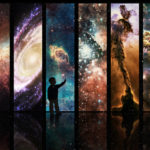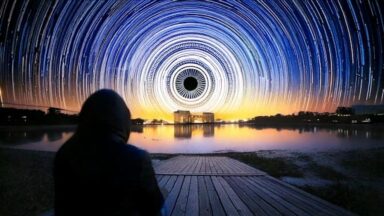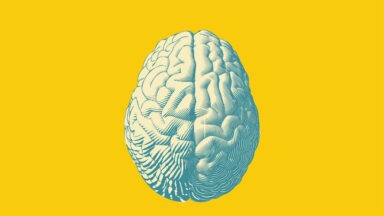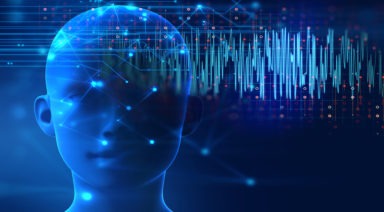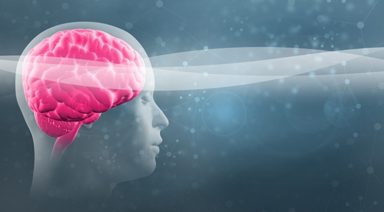The Only Thing That’s Real

“Any intelligent fool can make things bigger and more complex. It takes a touch of genius to move in the opposite direction.”
Albert Einstein
Depending whom you ask, reality is a relative thing. Each and every human collects life experience that colors his or her understanding of the world around them. This perspective is what we collectively call reality.
Some experiences — hunger, cold, bowel movements — are common enough to constitute our shared reality. Other scenarios — telepathy, UFOs, the Illuminati — are less common, making that which is incontrovertibly real for one person a frivolous flight of fancy for another.
The search for what is interminably real is the ultimate quest for spiritual seekers from every tradition. For physicists, the Holy Grail is that elusive “Theory of Everything.”
Though the names and methods may differ, there is a shared sense that underlying the infinite variety of manifest creation there must be some essential, unifying factor.
In the Hindu tradition — more accurately named sanatana dharma, or “the eternal natural way” — this unifying substratum of all existence is known as Brahman. Realization of Brahman is the only goal of life.
In physics, the pursuit of Brahman translates to solving for equations that unite relative and quantum theories, resolving the discrepancies in our current conceptions of micro- and macroscopic functions and demonstrating how infinities interact coherently within the finite.
Big ideas, yes? Not to worry — this simple blog will solve it all. We begin on the philosophical side.
Real vs Unreal
Vedanta is an ancient philosophy concerned with determining what is real versus unreal.
The word Veda means “knowledge.” The Vedas are the foundational texts of India’s timeless spiritual tradition (sanatana dharma). Vedanta is derived from the Upanishads, which are the final section of the Vedas. Vedanta literally means “the end of knowledge.” Interpreted one step further, the word Vedanta implies “that knowledge beyond which there is nothing to know.”
One of the practical methods offered for discerning real from unreal is the process of negation, known as neti neti, or “not this, not this.”
The assertion is that anything real is always real, and cannot be negated. Something unreal may appear for a time, but if it can be negated, it will sooner or later return to the non-existence from whence it arose.
Is the human body real?
Our instinctual answer is that yes, of course it is, but let us see. The body is a conglomerate of organ systems — skin, blood, fat, muscle, bone, etc. These organs are in constant flux. The lungs, for example, are rarely more than three weeks old; your taste buds are renewed every ten days.
Therefore, the body is not one stable, solid thing. It is ever changing, and reducible to its various components. As such, according to Vedanta, the body is unreal.
Okay, but what about those organs? Well, they are composed of billions of little cells. Those cells are each their own ecosystem, with a cell wall, cytoplasm, nucleus and so on.
Deeper still, each cell is made of atoms. The word atom comes from Greek and means “indivisible.” For many years after their discovery, atoms were considered the most fundamental unit of matter.
Near the end of the 19th century, however, the existence of subatomic particles was scientifically confirmed, allowing us to continue our current quest toward the tiniest body part, in search of something real.
If not atoms, electrons, right? If not electrons, surely then quarks. If not a quark, then perhaps the Higgs-Boson? At these extremely microscopic levels, the truth is that matter is almost entirely made of “empty” space.
I invite you to perform the neti neti experiment on everything you believe to be real. The result is always the same. As you break things down into their constituent parts, you find that at each level there is yet another layer to be negated. If it can be negated, it is not real.
You can zoom as far down as you like, using your imagination to transcend the limits of our most powerful microscopes, negating layer after layer, but with infinite recursion, at some point you just have to stop.
Realization of Brahman
Ultimately, the great philosophers and God-realized beings are on record insisting that only Brahman is real. This is where our intellectual exercise hits its limit, and the truth can only be experienced, never explained. But before you run off to meditate for several decades in pursuit of this experience, let’s see if some elementary geometry can help.
Geometric Dimensions
The first lesson in geometry concerns dimension. Here, let’s watch Nassim Haramein describe his experience as a schoolboy.
If you’re a Gaia subscriber (and if you’re not, you really should be), I highly recommend the documentary Black Whole. This same information is beautifully animated in the first 13 minutes of that film. For now, please watch this clip called Sacred Geometry and Unified Fields from about the 3:30 until the 8:30 mark.
If you just watched all 3 hrs and 36 minutes of Nassim’s presentation, you’re a genius now and know everything. For the rest of us, let’s walk through the process.
In the story, Nassim’s teacher leads the students through the dimensions. He says:
“The dot is Dimension 0, and it doesn’t exist… Then, [the teacher] put a bunch of dots together to make a line and called it Dimension 1, and said that didn’t exist either… Then, he put four lines together and made a plane, called it Dimension 2, and said that doesn’t exist either because it still doesn’t enclose volume… He took six of these non-existing planes, put them together to make a cube and said now the planes enclose volume, this is Dimension 3, and that’s the one you exist in.”
Nassim’s keen young mind is reeling with questions and contradictions now. He realizes that “… if the dot doesn’t exist, the line doesn’t exist, the plane doesn’t exist, then the cube can’t exist and you don’t have existence. You have non-existence to the 4th power.”
He didn’t know it at the time, but this is a problem with which some of our greatest thinkers have grappled — Pythagoras, Plato, Euclid, Buckminster Fuller — and no one has quite solved it.
Notice how this problem is not dissimilar from the Vedantic question about what is real. In both cases, we are confronted with the objectively provable unreality of everything we can see and touch and know to be real.
In the attempt to describe the essential nature of things, we quickly encounter a paradox so perplexing that most of us — yogis and astrophysicists alike — just ignore it and move on.
Unfortunately, as Haramein points out, “These fundamental axioms of geometry are what most of our math and physics are based on.”
The Dot
When our starting point is so deeply flawed, is it any wonder that the ensuing equations fail to satisfy our quest for a unified theory? As it turns out, Harramein has a solution.
“The way to solve the dimensional problem is to reverse the axiom completely and say, the only thing that exists is the dot.”
As per the neti, neti experiment, we know everything big to be made out of something small. In geometrical terms, the cube is made of planes. The plane is made of lines. The line is made of dots.
If, at this point, we agree that “the dot” is the most fundamental layer, unable to be negated, equivalent to Brahman, then some very interesting possibilities arise. Haramein observes,
“Within the dot is infinite amount of division. Everything is made out of dots, and the dots are arranged differently, and that makes up our whole world.”
In the film Black Whole, Haramein presents a series of graphics to illustrate what is meant by “within the dot,” and how a finite system can contain infinities.
First, we take a circle (which could be a sphere), and define it as our finite space (our dot, or boundary condition). Then, we divide that circle so that it encloses an equilateral triangle. Quoting from the film now:
“The universe is polarized. Everything in the universe seems to spin. Spin produces polarity. So we would have a reverse triangle at the same time.”
“We have now created a new boundary condition, at the next fractal level down, the next iteration down.”
“Notice that these new boundaries all are centered around a very specific center. Each of the boundaries define a very specific structure [or] coordinate in space-time. Therefore each of the boundaries can be defined as a very specific set of information.”
“I can continue to divide the space to produce new boundary conditions. Now I’ve got another iteration down, and another set of information… I can continue to do this and create new boundaries again, and at this point, you can imagine that if I give this to my computer… it could do this to infinity.
“However, I would never, ever, ever ever exceed that first boundary I produced for myself. So here, I’ve embedded infinite amount of divisions, infinite amount of information, within the confines of a finite space.
“So, in very simple terms I’ve shown to you that infinities and finite structures are complimentary… And if this is true, this simple concept could change all of our concepts of physics, including our concepts of our relationship to the universe.”
Infinity Is Within Us
The human body is a finite system. There is a physically identifiable place where our body ends and the outside world begins. And yet, the neti, neti experiment and Nassim Haramein’s geometry prove that this finite system can and indeed does contain infinities.
Is this not what every great spiritual tradition has promised? That divinity (infinity) dwells within us? Well, here’s the mathematical proof.
As described in my previous article, The Thing That Connects All Things, the spherical electromagnetic field encircling every human makes us literally dot-like. According to Quadrivium, “Einstein discovered that a point in four dimensions (i.e. you here and now) is a sphere expanding at the speed of light, and all we can see of the entire universe is inside an event horizon sphere.”
Meaning: We are so many billions of individual dots zipping around within the confines of a larger dot named Earth. Dot Earth plays its role along with other planet-dots composing the grand dot that is our solar system, which itself is just one dot among billions within the incomprehensibly magnificent dot that is the Milky Way galaxy. Onward we zoom endlessly out and out into the expanse of space, never escaping the primeval dot we call Brahman.
One characteristic of Brahman is that it is always full. Which is to say, it cannot be added to or subtracted from. Every other dot could disappear today and that Brahman dot would remain as it is, whole and complete.
Ostensibly, Brahman is the primary dot, providing the field within which all subsequent dots arise, exist and subside. It doesn’t matter how far we zoom in or out, or how many iterations or geometric variations arise, we are still within the scope of that first dot, the singularity.
Fractal Singularity
In “The Power of Spin,” a short film produced by The Resonance Project, Dr Michael Hyson says:
“If you think of the whole universe as a fractal series of singularities…There’s really only one thing in the whole universe, it’s all just folded up a lot — into trees and dolphins and honey bees and humans — but we’re all made of the same stuff. And if all the information is available in the event horizon [the boundary condition], then all the information in the entire universe is available from every point.”
You are one of these points. So am I. Deep within we know this, except we exist in a state of constant forgetting. If and when we remember this profound reality, then all the information in the universe is suddenly at our fingertips, infused into every cell of our being.
This is a massive download, I know, but give it a try. The third dimension wherein we live is inherently fickle, literally a light speed blur of opposite pairs flickering on and off, in and out of “reality.” When finding ourselves inside out and upside down, it is of great benefit to remember what is real and what is not. Only Brahman is real. There is only the dot.
Image Sources:
- Main article image courtesy of Cosmic Armour Art by Anna Kumashov and used with permission.
- “Within the dot” images are from the film Black Whole (links above), available for your viewing pleasure right here on Gaiam TV.
- Electromagnetic field is from The Resonance Project’s facebook page.
- Universe image is from the film Thrive: What on Earth Will it Take, also available right here on Gaiam TV.
The Mandela Effect: CERN and Hidden, Parallel Universes

The concept of The Mandela Effect is simple. Over time, a few minor details surrounding significant events, and therefore our perception of these events, might somehow change and may continue to improve in the years ahead.
In other words, the tried and true spacetime continuum that appears to be the backbone of our collective, three-dimensional, physical reality might have a ripple in it. It also may have produced a sister, parallel universe, which has birthed different scenarios, events, identities, constructs, and relationships.
It might also be true that our tiny, insignificant brains are slowly evaporating and can no longer handle every detail that flashes across our eyes. As we forget events, out of fear, we attempt to reassemble them in our imperfect minds.
Given that we’re all probably of the same species, each of our brains might make mistakes that are akin to the next, especially when it comes to certain types of events and sets of details.
It’s important to consider that our brains are continually comparing, analyzing and constructing ideas and memories to justify their notions of reality, often from poorly assembled concepts and thin air. Given that, it might be fair to say that all brains build memories and memory-bridges with similar strategies and outcomes.
All this to say that because of our shared DNA, our brains will construct similar data sets and similar conclusions.
Maybe this is the question we’ve yet to ask: Have large groups of people moved backward or forwards in time, witnessed potential trajectories, returned to their primary spacetime paths, and then somehow integrated all collected information into new perspectives, refreshed with new sets of details?
“If (quantum theory) is correct, it signifies the end of physics as a science.”
— Albert Einstein
Whether you believe The Mandela Effect to be fact or fiction, the growing number of shared perspectives across a variety of ideas and events, and inclusive of a broad spectrum of socioeconomic backgrounds, is compelling.




